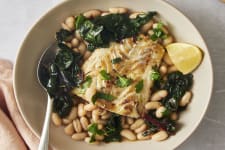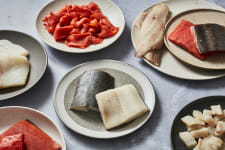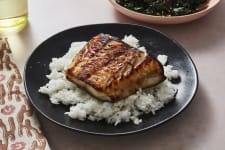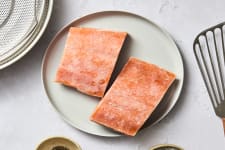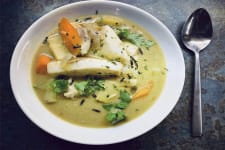
What It Means to “Follow the Fish”
April 17th, 2025Considering Earth Day With a Piece by Melanie Brown
Science and sustainability. Building legacy. The ethos of living in concert with nature. These are a handful of the overarching themes that first inspired my husband Arron Kallenberg to found Wild Alaskan Company. These themes continue to guide the company to this day, helping to illuminate the path forward as we evolve and grow.
With Earth Day around the corner, I feel pleasantly overwhelmed by the multitude of directions in which I am being pulled. And that’s when this Earth Day’s theme came to me: Trust the fish.
I’ve learned many things from Arron, but perhaps one of the most idiosyncratic is this idea of “trusting the fish.” His unique perspective as both an Alaskan and as a Kallenberg — a family with multigenerational ties to wild salmon — has culminated in this quirky, seemingly simple aphorism. Put simply, it’s an acknowledgement that wild salmon have much to teach us, if we are willing to take their lead. That salmon’s instinctual journey through life can guide us when our life’s compass is spinning.
This train of thought led me to the words and wisdom of our good friend Melanie Brown, whose work as a commercial fisherman and salmon advocate is complemented beautifully by her work as a writer and musician. In honor and celebration of Earth Day, I’ve asked Melanie to write a piece for us that I believe brings this idea of “trusting the fish” to life. She begins her essay with lyrics from one of her compositions.
***
Your Body Feeds the World Around You
By Melanie Brown
“Pulsing filled with purpose, flash of silver light, jumping joy grouped in a movement, your return brings us life.
When it’s time to go home you know, the pull of your home stream guides you, giving spawn to young you’ll never see, your body feeds the world around you”
– “Salmon Song” lyrics by Sunny Porch
Salmon feed the world in so many ways. Their lives serve as an inspiration for how I aspire to live as a human being, and I would also posit that the world would be a better place if we followed the example of salmon.
Salmon begin their lives in the gravel of the freshwater environment where their spawning pair parents deposited them. After consuming the nutrients provided within their own egg sac, they leave the gravel and feed in their river and lake system on zooplankton that was fertilized by the bodies of their parents, in preparation to go out into the ocean as juveniles. The salmon journey far and wide as they feed and grow to adult size. When they reach full maturity, they set themselves on going home to find a spawning partner and deposit fertilized eggs in a gravel nest, beginning the cycle anew.
The circular loop that marks the lifecycle of salmon is one that conveys growth and development, returning to one’s roots and sharing by giving back. To relate this in the simplest terms, salmon give everything back when their bodies swim to their home streams.
When I first began my work as a salmon advocate, I learned from Dr. Carol Ann Woody, a salmon scientist, that nitrogen carried from the ocean in the bodies of salmon can be measured by sampling feathers, fur and hair. In other words, it is possible to see how much nutrition a bird, bear or human derives from salmon through sample testing.
Flora is fed by the salmon, too. I later learned from photographer Amy Gulick that it is possible to measure how much salmon nutrients are taken up by trees through core sample testing. Amy compiled a book of her photographs and interviews of people who live in the Tongass National Forest in Southeast Alaska, where spawning salmon enrich these waterways with their bodies, greatly accelerating the growth of Sitka spruce situated near the stream's edge. The book is called “Salmon in the Trees”, and I highly recommend it.
If you ever have the chance to fly into Bristol Bay over the tundra, this effect is visible to the naked eye when you look at the intricate system of rivers, lakes and sloughs. It is easy to see where the salmon have gone to spawn and die because you will see a bright green bloom adjacent to the waters where they have been. Even herbivores benefit from the gift that salmon bring back to the land by browsing on the leaves of bushes and trees that grow by the water’s edge.
I am struck by how salmon, as an anadromous fish, teach us to recognize that the land and sea are inextricably linked ecosystems; salmon cannot exist without both habitats, and their return to the land benefits the habitat they were reared in.
My work outside of fishing is centered around making it possible for salmon to continue to complete their life cycle so that they will carry on. This purpose benefits from a wider focus to see the world as a giant ecosystem that recognizes the need to bring in the values of growth, return and sharing. Embodying the values of salmon just might help us to not only save salmon, but the whole Earth ecosystem that we live in.
***
Salmon is just one point of connection — one that, naturally, is very dear to us — between Mother Nature and our collective, human efforts to imagine a better planet. But there are so many other points of connection, so many other creatures and plants and cycles and formations that can guide our way forward, if we are willing to follow.
Have you ever felt moved by nature — even perhaps learned a life-changing lesson? I invite you, dear members, to take a moment to reflect on this, and the power of forever savoring these epic gifts from the universe.
Live Wild,
Monica
Pictured above: From Melanie’s camera roll, an aerial shot of the Nushagak River system, near Dillingham, Alaska. A green bloom in the water is visible to the naked eye — a marker of the nitrogen-rich ecosystem that’s supported by the bodies of spawned salmon.
